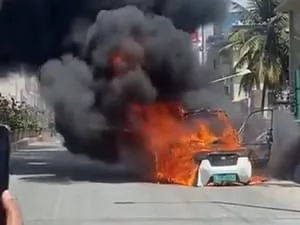Electric car catches fire in Bengaluru

Electric car catches fire in Bengaluru
Bengaluru : In a recent incident that occurred in Bengaluru, an electric car caught fire in close proximity to Dalmia Circle in the J P Nagar area, resulting in a distressing scene that has gained widespread attention on social media platforms.
Fortunately, there have been no reported casualties, although the cause of the fire remains unknown. Instances of electric vehicle fires, while infrequent in theory, tend to garner significant public interest when they do transpire. These occurrences are primarily attributed to the high energy density of electric vehicle battery packs, which store a substantial amount of energy within a confined space.
When the battery pack sustains damage, an internal short circuit can initiate a chain reaction referred to as thermal runaway. Throughout this process, the battery generates an excess of heat that surpasses its capacity for dissipation, ultimately resulting in a fire. Approximately 95% of battery fires in electric vehicles are categorized as ignition fires, characterized by the production of directional flames resembling a jet.
The remaining 5% involve an explosion caused by a vapor cloud. Numerous factors can contribute to a battery catching fire, including physical damage incurred during accidents, manufacturing defects, battery malfunctions, repairs conducted in workshops, deliberate acts of arson, external fires, or overheating.
Electric vehicle fires present unique challenges that require careful management. When batteries ignite, they become difficult to control and pose significant risks. Lithium battery fires burn at extremely high temperatures, persisting for extended periods and causing extensive damage.
Furthermore, these fires have a tendency to reignite even after appearing to diminish. Inadequate handling of such incidents can lead to the release of highly toxic gases and chemicals for prolonged durations, underscoring the necessity for adequately trained firefighting teams.
Various methods are employed to combat these fires, including the application of water to cool the battery or the utilization of a crane to lift the vehicle and submerge it in a large water container. It is imperative to approach these situations with utmost caution to ensure the safety of both firefighters and the general public. Interestingly, e-scooters and e-bikes face a higher susceptibility to battery fires compared to electric cars and trucks.
This heightened risk primarily stems from substandard battery design and construction, as well as the use of unapproved chargers. In contrast, electric cars and trucks boast more sophisticated designs equipped with advanced cooling systems. These systems effectively maintain the batteries at optimal temperatures during regular driving and recharging, rendering them significantly safer than those found in smaller electric vehicles.
Madhupriya Dhanwate








